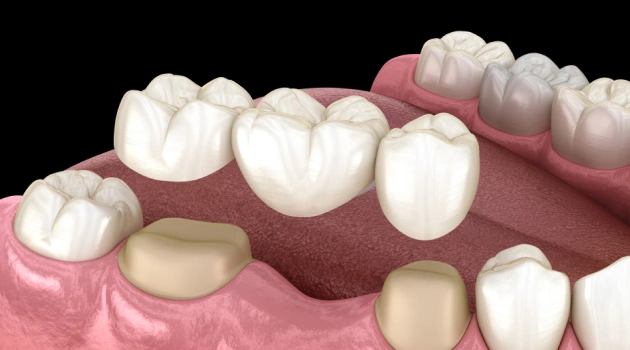
What is a Dental Bridge?
Dental bridges are designed to replace a missing tooth and stabilize the surrounding teeth on either side of the gap. While there are several types of bridges available, most consist of a false tooth (called a pontic) supported by one or more adjacent teeth. Unlike a dental implant, which is rooted directly in the jaw, a tooth replaced by a bridge is attached to the neighboring teeth for support.
Traditional Bridge
The most common type of dental bridge is the traditional bridge, which features a pontic tooth anchored by two dental crowns that cover the adjacent teeth. To accommodate the crowns, the dentist will need to file down the neighboring teeth. These crowns, often referred to as abutments, are placed over the reshaped teeth and secured with a composite bonding resin.
Cantilever Bridge
A cantilever bridge is similar to a traditional bridge, but the pontic is attached to only one abutment instead of two. Since it is secured on just one side, this type of bridge is primarily used for teeth located at the back of the mouth.
Maryland Bridge
The final type of bridge is known as a Maryland bridge. Instead of using crowns to secure the pontic, this bridge employs metal or porcelain bands that attach to the neighboring teeth with bonding resin. The primary advantage of this method is that it doesn’t require any filing down of your teeth. However, the downside is that Maryland bridges are generally weaker than traditional bridges and may not be suitable for replacing molars, which experience greater strain during chewing.
Procedure Overview
Getting a dental bridge is a more involved process than a standard checkup. If you've had a dental crown before, the experience will be quite similar. It typically requires multiple appointments to prepare your teeth and fit the bridge. Any necessary dental work on the supporting teeth, such as fillings or root canals, should be completed beforehand.
- After completing any necessary treatments, the dentist will remove enamel from the supporting teeth to accommodate the abutment crowns.
- A mold of the area will be taken and sent to a lab to create your custom bridge, which typically takes a few weeks.
- While you wait for your personalized restoration, you will receive a temporary bridge.
- During your final appointment, the dentist will place your permanent bridge and make any needed adjustments for optimal fit.
The lifespan of your bridge depends on how well you care for it. With proper maintenance, a dental bridge can last over 10 years. To ensure its longevity, brush your teeth twice a day, floss at least once daily, clean underneath the pontic, and visit us for regular cleanings and maintenance.